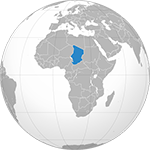Overview
More than 4.3 million people are in need of humanitarian assistance in Chad, mostly because of chronic poverty, conflict, food insecurity, and malnutrition, particularly in the Sahelian zone in the north.?
Security threats around Lake Chad, most notably from Boko Haram (BH), and military operations to contain them have driven civilians from their homes and disrupted livelihoods. Insecurity has also pushed Nigerian refugees into Chad since 2014, creating a complex displacement crisis across the islands and shores of Lake Chad. Large and protracted refugee populations, mainly from Sudan and CAR, in the south and east of the country also face significant humanitarian needs. ?
Regional instability coupled with a severe economic crisis has challenged the country, however recent harvests have contributed to the country's food security.?A measles outbreak beginning May 2018 continues and has intensified in 2019. As of December 2019, 25,916 cases including 255 deaths were identified in 7 of the country's districts.?
Latest Developments
On 21 April, heavy rains affected a returnee site in Maïngama, Moyen-Chari region in southern Chad. Rains damaged or destroyed the shelters of nearly 6,000 of the 10,000 people living at the site ( over 60% of shelters on site). One person was killed and 61 were injured. Many affected households are staying with family or neighbours but more than 2,000 people are staying in the open, most of them women and children. Priority needs are shelter and NFIs, support to local health centres and immediate food assistance for the affected population – especially children under five and pregnant women, hygiene kits and clean water.?
The situation of Chadian returnees living in Logone Oriental, Moyen-Chari, Mandoul, and Salamat regions has been deteriorating for almost four years. Around 117,000 returnees are estimated in Chad, including some 70,000 living in host sites and villages in the south of the country.
ACAPS' team is daily monitoring the impact of COVID-19. Find more information related to the outbreak here.
Key Figures
INFORM Global Crisis Severity Index
Crisis Severity: 3.9
Impact: 3.7
Humanitarian Conditions: 4
Complexity: 3.9
Access Constraints: 3
Information courtesy of ACAPS. https://www.acaps.org/
Key Figures - 2020 HPC
in need
reached
Objectives
- Contribuer à l'amélioration des conditions de vie des populations par la coordination des activités des partenaires CCCM en faveur des personnes déplacées, retournées et ressortissants des pays tiers.
- Améliorer la coordination et la gestion des sites d’accueil des personnes déplacées internes, les retournés et les ressortissants des pays tiers au Tchad avec inclusion des personnes vivant avec handicap et la considération environnementale.
- Assurer le suivi de mouvements des populations à travers un système cohérent et fonctionnel dans les sites de déplacement gérés par l’acteur CCCM.
- Contribuer à l’acquisition des terres cultivables et des nouveaux sites d'installation aux personnes déplacées internes, retournés vivant dans les sites couverts par le CCCM leur permettant l’auto-prise en charge de façon progressive.
Projects (2019)
- Assistance multisectorielle sur les îles de retour
- Coordination et assistance en abris et articles ménagers essentiels pour les déplacés internes, retournés et population hote vivant dans la Region du Lac Tchad
- Projet d’Appui à la solution durable des personnes vulnérables retournés et déplacés, affectés par la crise des ex-Boko-haram dans le bassin de lac Tchad
| Title | Uploaded |
|---|---|
| CCCM Cluster Chad - Terms of Reference | 01 Jul 2014 |
| Title | Type | Theme | Attachment |
|---|---|---|---|
| Chad CCCM Training - August 2018 | Package module | Coordination, GBV, Gender |
| Title | Posted on |
|---|---|
| UAE Sends Medical Aid to Iraqi Kurdistan in Fight against COVID-19 | 28 Jun 2020 |
| Iraq COVID-19 Food Security Monitor Weekly Update - Issue 10, 23 June 2020 [EN/AR] | 28 Jun 2020 |
| Iraq’s health system at risk: the struggle to fight COVID-19 and save lives | 26 Jun 2020 |
| UAE Sends Medical Aid to Iraq in Fight against COVID-19 | 26 Jun 2020 |
| Iraq: ISHM: June 18 - 25, 2020 | 25 Jun 2020 |
10 Common Operating Datasets or CCCM-tagged datsets are on the Humanitarian Data Exchange:
- Chad Displacement Data - Site Assessment [IOM DTM] - International Organization for Migration (IOM) - 01/16/2020-04/30/2020
- Chad - Villages - Institut National de la Statistique, des Etudes Economiques et Démographiques du Tchad - 03/11/2020
- Chad Displacement Data - Baseline Assessment - Returns - Region Logone Oriental - [IOM DTM] - International Organization for Migration (IOM) - 10/02/2019-11/12/2019
- Chad Displacement Data - Baseline Assessment - Returns - Region Moyen Chari - [IOM DTM] - International Organization for Migration (IOM) - 10/02/2019-11/13/2019
- Chad Displacement Data - Baseline Assessment [IOM DTM] - International Organization for Migration (IOM) - 08/01/2019-09/26/2019

